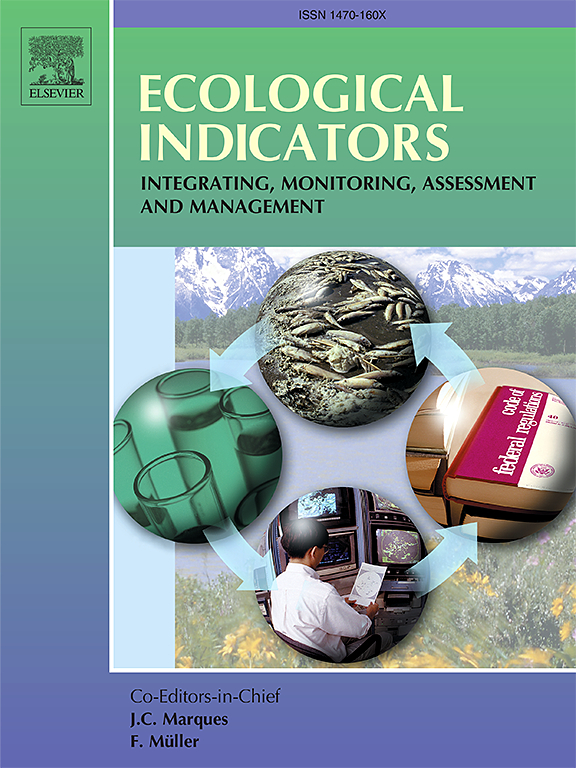Collaborative allocation of water resources considering ecological marginal benefits in a semiarid and cold region
IF 7
2区 环境科学与生态学
Q1 ENVIRONMENTAL SCIENCES
引用次数: 0
Abstract
Water resource optimization allocation is essential for maintaining ecological balance, promoting economic development, and ensuring social stability within river basins. However, many existing studies treated ecological water requirements as static baselines in allocation models, failing to address the dynamic utilization of water resources efficiently under varying hydrological conditions. In the Tao’er River Basin, a typical semiarid river basin, the combined effects of climate change and human activities have led to a severe imbalance between water supply and demand, particularly in regard to the competition between ecological water replenishment for the Xianghai Wetland, agricultural irrigation, and social water use. There is an urgent need for optimized water resource allocation to ensure the coordinated and sustainable development of these sectors. In this study, we developed the WEP-L model, a coupled natural–societal system, using various ecohydrological monitoring data to analyze the water supply–demand balance under different hydrological conditions. We proposed an allocation plan that considers ecological marginal benefits, agricultural needs, and water use guarantees: 1.04 × 108 m3 for ecological supplementation and 5.16 × 108 m3 for agricultural water in the flat year, adjusted to 0.94 × 108 m3 and 3.60 × 108 m3 in the dry year, respectively. Furthermore, by incorporating reservoir water supply rules into the WEP-L model, we simulated the feasibility of intra-annual water allocation. The proposed allocation scheme concentrates ecological water in spring during flat years and distributes it at a ratio of 80 % in spring and 20 % in autumn during dry years. This study emphasizes the dynamic adjustment of ecological water resources on the basis of environmental conditions and societal needs, aiming to maximize ecological and social benefits. It provides scientific support for optimizing ecological water allocation and offers practical guidance for wetland conservation, agricultural water management, and water resource policy-making.
考虑生态边际效益的半干旱寒区水资源协同配置
水资源优化配置对维护流域生态平衡、促进流域经济发展、保障流域社会稳定具有重要意义。然而,现有的许多研究将生态需水量作为分配模型的静态基线,未能有效解决不同水文条件下水资源的动态利用问题。洮儿河流域是典型的半干旱河流流域,在气候变化和人类活动的共同作用下,水资源供需严重失衡,特别是在向海湿地生态补水、农业灌溉和社会用水之间的竞争。为保证这些部门的协调和可持续发展,迫切需要优化水资源配置。本研究利用多种生态水文监测数据,建立了自然-社会耦合系统WEP-L模型,分析了不同水文条件下的水资源供需平衡。提出了综合考虑生态边际效益、农业需求和用水保障的配置方案:平旱年生态补给量1.04 × 108 m3,农业用水5.16 × 108 m3,旱年调整为0.94 × 108 m3和3.60 × 108 m3。此外,通过将水库供水规律引入WEP-L模型,模拟了年内水资源分配的可行性。提出的分配方案在平旱年将生态水集中在春季,在干旱年按春季80%、秋季20%的比例分配。本研究强调根据环境条件和社会需求对生态水资源进行动态调整,以实现生态效益和社会效益的最大化。为优化生态水资源配置提供科学支撑,为湿地保护、农业用水管理和水资源决策提供实践指导。
本文章由计算机程序翻译,如有差异,请以英文原文为准。
求助全文
约1分钟内获得全文
求助全文
来源期刊

Ecological Indicators
环境科学-环境科学
CiteScore
11.80
自引率
8.70%
发文量
1163
审稿时长
78 days
期刊介绍:
The ultimate aim of Ecological Indicators is to integrate the monitoring and assessment of ecological and environmental indicators with management practices. The journal provides a forum for the discussion of the applied scientific development and review of traditional indicator approaches as well as for theoretical, modelling and quantitative applications such as index development. Research into the following areas will be published.
• All aspects of ecological and environmental indicators and indices.
• New indicators, and new approaches and methods for indicator development, testing and use.
• Development and modelling of indices, e.g. application of indicator suites across multiple scales and resources.
• Analysis and research of resource, system- and scale-specific indicators.
• Methods for integration of social and other valuation metrics for the production of scientifically rigorous and politically-relevant assessments using indicator-based monitoring and assessment programs.
• How research indicators can be transformed into direct application for management purposes.
• Broader assessment objectives and methods, e.g. biodiversity, biological integrity, and sustainability, through the use of indicators.
• Resource-specific indicators such as landscape, agroecosystems, forests, wetlands, etc.
 求助内容:
求助内容: 应助结果提醒方式:
应助结果提醒方式:


